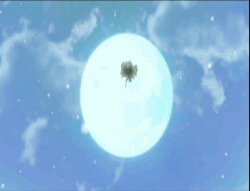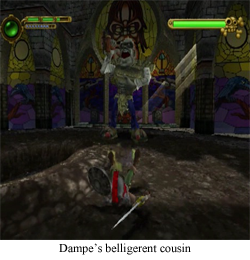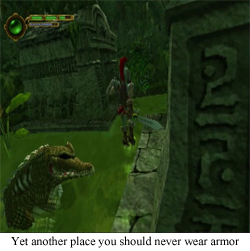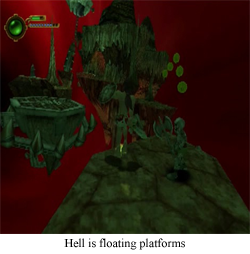 Because I don’t sleep and my train of thought is constantly rolling on, I often wonder to myself which video game generation is my favorite. The 16-bit era is an obvious choice, as some choice games originated there (Chrono Trigger tattoos don’t just happen), and it was the first time graphics reached an echelon where the abstractions of previous generations gave way to something that actually resembled real art (cartoons are real art). Then there’s the Playstation/N64 days, which had another crop of darling games, and was, basically, the time when games started to eschew the simplicity of “just go save the princess already” for giant sprawling plots, the likes of which I never would have imagined possible back in the NES days. Come to think of it, to this day I’m still kind of surprised that Xenogears happened at all…
Because I don’t sleep and my train of thought is constantly rolling on, I often wonder to myself which video game generation is my favorite. The 16-bit era is an obvious choice, as some choice games originated there (Chrono Trigger tattoos don’t just happen), and it was the first time graphics reached an echelon where the abstractions of previous generations gave way to something that actually resembled real art (cartoons are real art). Then there’s the Playstation/N64 days, which had another crop of darling games, and was, basically, the time when games started to eschew the simplicity of “just go save the princess already” for giant sprawling plots, the likes of which I never would have imagined possible back in the NES days. Come to think of it, to this day I’m still kind of surprised that Xenogears happened at all…
And then there are the Playstation 2 years. This was an interesting time for the franchises that had existed since the NES era. Seemingly content with the epic stories that had been told in the previous generation, a number of franchises went in some fascinating directions. The main-line Mario entry of the generation told not the simple story of boy saves girl (even though it included that), but the story of a man just trying to enjoy his mundane vacation and becoming waylaid into adventure. Luigi’s Mansion, already notable for launching a system with a game starring Player Two, seemed to imply that Bowser had been finally “defeated” in a previous game, and that this house of phantoms might be all that remains of the infamous big bad. Even Link sailed a drowned Hyrule in the name of leaving the old ways behind. Other franchises got deeply meta: Mega Man was a digital avatar in a computer world “played” by a normal teen, and the Prince of Persia could enjoy “save scumming” and write-off death with a simple, “That didn’t happen.” One might get the impression that the gatekeepers of gaming were bored with the same old stories, and were toying with new plots like they had experimented with 3-D movement or advanced graphics in the previous generations.
 It was during this time that Ghosts ‘n Goblins was revived with its new star, Maximo. The “real” Ghosts ‘n Goblins franchise hadn’t seen a new release since the launch of the Super Nintendo; though, in a way, it also closed out that system with the sublime Demon’s Crest, which, if memory serves, sold negative copies. Demon’s Crest was merely a spin-off of the GnG series, but it was perhaps DC’s dismal sales that stalled the franchise for a generation. Besides, Capcom already scored itself a “spooky” hit on the Playstation with Resident Evil, why confuse the poor, easily-muddled gaming audience with another scary game that contained legendary difficulty and limited saving?
It was during this time that Ghosts ‘n Goblins was revived with its new star, Maximo. The “real” Ghosts ‘n Goblins franchise hadn’t seen a new release since the launch of the Super Nintendo; though, in a way, it also closed out that system with the sublime Demon’s Crest, which, if memory serves, sold negative copies. Demon’s Crest was merely a spin-off of the GnG series, but it was perhaps DC’s dismal sales that stalled the franchise for a generation. Besides, Capcom already scored itself a “spooky” hit on the Playstation with Resident Evil, why confuse the poor, easily-muddled gaming audience with another scary game that contained legendary difficulty and limited saving?
Speaking of difficulty, the GnG mantra always seemed to be “tough but fair”. Your jumping, shooting, and even weapon selection required a great degree of precision to make any progress. Ask any NES kid about Ghosts ‘n Goblins, though, and you’ll receive one of two responses:
- “Oh my god, that game was hard. I died so many times! Never did get past that second level. You know? With those flying things? And the guys that punch fire at you? Argh, so hard.”
- “Oh yeah, I beat that game. Did it all without continuing. Yep.”
Please note that Dude #2 is a liar. Nobody got past the second level of Ghosts ‘n Goblins. It was only after the advent of emulation and save states that anyone even discovered the third level, left alone the sadistic “now play the game all over again” message at the end of the supposed final level. Actually, maybe that whole bit is some kind of copy protection scheme, as no one has ever reached that point on the original hardware. While the series was slightly less difficult in later iterations (the Atlantic Ocean is slightly less salty than the Pacific Ocean), one thing was clear in the Ghosts ‘n Goblins franchise: you are going to die.
 So I think we can all appreciate the designers of Maximo: Ghosts To Glory who went the extra mile and decided to kill Maximo right from the moment the player presses Start. They’re just saving everybody time. For those of you unfamiliar with the game, Maximo: Ghosts to Glory begins with King Maximo returning to his kingdom to find rival King Achille has captured Maximo’s kingdom, queen, and afterlife. Now imbued with unholy power and dominion over life and death, Achille murders Maximo with nary a second thought. But, good news, the Grim Reaper, capital D Death himself, negotiates Maximo’s life for his pledge to strike down King Achille and put a halt to all this messy spirit-sucking business the evil king has gotten into. Maximo complies, and he’s off to rescue a quartet of priestesses to banish King Achille to Hell, a location Maximo will also franticly leap around.
So I think we can all appreciate the designers of Maximo: Ghosts To Glory who went the extra mile and decided to kill Maximo right from the moment the player presses Start. They’re just saving everybody time. For those of you unfamiliar with the game, Maximo: Ghosts to Glory begins with King Maximo returning to his kingdom to find rival King Achille has captured Maximo’s kingdom, queen, and afterlife. Now imbued with unholy power and dominion over life and death, Achille murders Maximo with nary a second thought. But, good news, the Grim Reaper, capital D Death himself, negotiates Maximo’s life for his pledge to strike down King Achille and put a halt to all this messy spirit-sucking business the evil king has gotten into. Maximo complies, and he’s off to rescue a quartet of priestesses to banish King Achille to Hell, a location Maximo will also franticly leap around.
Ghosts ‘n Goblins may have left the arcade long ago, but Maximo refreshes one old arcade trick to hold the player’s interest through this difficult adventure. Rarely seen outside fighting games nowadays, the “continue countdown” that was a standard for arcade cabinets played a subtle bit of psychological warfare with the player. You want to beat this game? Well, you failed. You can try again, but time is running out, ticking down, second by second. Feed me another quarter within ten seconds… oh… just nine now, or I’ll find someone else. Nobody likes to drop their progress, but even worse, in a sequential video game, is losing and then seeing some other shmuck rescue the princess. I thought we had something special, random inanimate arcade cabinet! Sorry, player, you’re replaceable.
It’s with that innuendo that Maximo: G2G toys with your feelings. You’re dead right from the first minute of this story, and are only venturing forth thanks to the pity of Death himself. Fail to stop Achille’s machinations, lose your next life to an errant skeleton, and guess what? You’re not holding up your part of the deal. Fail to prove yourself to Death, and Death is going to find somebody else. Maximo: G2G is a difficult game, complete with bottomless pits and a host of enemies that seem to have been designed to lull you into a false sense of security and then wrest it away with new patterns and traps for the unwary, but if you give up, if you fail, then some other undead jerk is going to save the world, someone else will steal all the glory. Fight on, or wallow in obscurity. Long live the real king while you rot.
 It’s no accident that death and Death both become deeply ingrained in the play experience of a game known for its difficulty. You’re going to be seeing that reaper a lot as you learn the ropes, so it can only enhance the experience to know exactly why he’s chortling at you. And while you may be laughed at, Death can be bargained with; he accepts (his own) currency, and will keep you around as long as you’re useful to him. In summation, these PS2-era designers created a Grim Reaper, a final judge, that is tough, but fair.
It’s no accident that death and Death both become deeply ingrained in the play experience of a game known for its difficulty. You’re going to be seeing that reaper a lot as you learn the ropes, so it can only enhance the experience to know exactly why he’s chortling at you. And while you may be laughed at, Death can be bargained with; he accepts (his own) currency, and will keep you around as long as you’re useful to him. In summation, these PS2-era designers created a Grim Reaper, a final judge, that is tough, but fair.
Gee, where have I used that phrase before?
FGC #47 Maximo: Ghosts to Glory
- System: Playstation 2, though also available on Playstation 3.
- Number of Players: Just the undead king himself, Maximo.
- Skeletons? By the boneful.
- Difficulty: Very high! Saving is an available asset, but it costs 100 coins every time you want to write your journey to the memory card. This wouldn’t matter too much, except all of your hard earned, and possibly hard purchased, power-ups are lost upon death, so it’s very tempting to reload from a previous save with every defeat. Didn’t decide to shell out for that savepoint? Well, too bad, hope you enjoy being back at square one with a dramatically weakened Maximo. And, oh yeah, the game is just kind of generally difficult even without that (significant) factor. It’s pretty thoughtful design for a game that was inevitably planned to be “difficult” from the start.
- So, did you beat it? Yep, with 87% completion, whatever that’s worth. I remember getting as far as the second world before just giving up on 100% and moving on to whatever game came next. Huh. Game saves should allow you to leave notes to your future self to remind you of the latest hotness of the past.
- Going to compare the game to a more contemporary “dark” franchise known for its calculated death mechanics and extreme difficulty? I can’t imagine to what you’re referring.
- Did you know? This game had some prototype conception for the N64 and Dreamcast before it came to realization on the Playstation 2. Then it had a sequel, which should have been titled Gears ‘n Gallantry, but wasn’t, so I’m not going to make eye contact with it until it apologizes. Then there was supposed to be a third Maximo title, but it never materialized. And that was it for the Ghosts ‘n Goblins franchise, forever.
- What about the PSP? Or iDevices? I said forever, and I’m sticking to it.
- Would I play again? Probably not. I have fond memories of Maximo, but it requires so much exactness and practice, it’s not so much a game to play for fun as it is a nearly unending challenge. And there’s always new challenges waiting.
What’s next? Random ROB has chosen… Space Station Silicon Valley. It’s time to study the ecological effect of robot animals in space. With wheels. And missiles. Please look forward to it!

[…] Gobilins game! In the year 2021! And it is a 2-D “old school” title like its forebearers! No 3-D Maximo for this Arthur! And, in a lot of ways, it follows the Contra 4 model of being “the most Ghosts […]
[…] old, but, when it was released, this now-retro game was meant to be a retro throwback itself. After Maximo failed to revitalize Capcom’s ancient GnG francise (and well after a certain Demon similarly […]